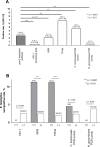Seroprevalence of Entamoeba histolytica at a voluntary counselling and testing centre in Tokyo: a cross-sectional study
- PMID: 32102805
- PMCID: PMC7044870
- DOI: 10.1136/bmjopen-2019-031605
Seroprevalence of Entamoeba histolytica at a voluntary counselling and testing centre in Tokyo: a cross-sectional study
Abstract
Background: Amebiasis, which is caused by Entamoeba histolytica, is a re-emerging public health issue owing to sexually transmitted infection (STI) in Japan. However, epidemiological data are quite limited.
Methods: To reveal the relative prevalence of sexually transmitted E. histolytica infection to other STIs, we conducted a cross-sectional study at a voluntary counselling and testing (VCT) centre in Tokyo. Seroprevalence of E. histolytica was assessed according to positivity with an ELISA for E. histolytica-specific IgG in serum samples collected from anonymous VCT clients.
Results: Among 2083 samples, seropositive rate for E. histolytica was 2.64%, which was higher than that for HIV-1 (0.34%, p<0.001) and comparable to that for syphilis (rapid plasma reagin (RPR) 2.11%, p=0.31). Positivity for Chlamydia trachomatis in urine by transcription-mediated amplification (TMA) was 4.59%. Seropositivity for E. histolytica was high among RPR/Treponema pallidum hemagglutination (TPHA)-positive individuals and it was not different between clients with and without other STIs. Both seropositivity of E. histolytica and RPR were high among male clients. The seropositive rate for anti-E. histolytica antibody was positively correlated with age. TMA positivity for urine C. trachomatis was high among female clients and negatively correlated with age. Regression analysis identified that male sex, older age and TPHA-positive results are independent risk factors of E. histolytica seropositivity.
Conclusions: Seroprevalence of E. histolytica was 7.9 times higher than that of HIV-1 at a VCT centre in Tokyo, with a tendency to be higher among people at risk for syphilis infection. There is a need for education and specific interventions against this parasite, as a potentially re-emerging pathogen.
Keywords: diagnostic microbiology; epidemiology; parasitology; public health; sexual medicine; tropical medicine.
© Author(s) (or their employer(s)) 2020. Re-use permitted under CC BY-NC. No commercial re-use. See rights and permissions. Published by BMJ.
Conflict of interest statement
Competing interests: None declared.
Figures



Similar articles
-
Seroprevalence of Entamoeba histolytica infection in female outpatients at a sexually transmitted disease sentinel clinic in Tokyo, Japan.Jpn J Infect Dis. 2008 May;61(3):175-8. Jpn J Infect Dis. 2008. PMID: 18503164
-
Seroepidemiology of anti-Entamoeba histolytica antibody by enzyme-linked immunosorbent assay in the greater Tokyo area.Tokai J Exp Clin Med. 1991 Dec;16(5-6):253-8. Tokai J Exp Clin Med. 1991. PMID: 1820666
-
Seroprevalence of Entamoeba histolytica infection among Chinese men who have sex with men.PLoS Negl Trop Dis. 2013 May 23;7(5):e2232. doi: 10.1371/journal.pntd.0002232. Print 2013. PLoS Negl Trop Dis. 2013. PMID: 23717699 Free PMC article.
-
Application of the polymerase chain reaction (PCR) in the epidemiology of Entamoeba histolytica and Entamoeba dispar infections.Tokai J Exp Clin Med. 1998 Dec;23(6):413-5. Tokai J Exp Clin Med. 1998. PMID: 10622639 Review.
-
Public health and clinical importance of amoebiasis in Malaysia: a review.Trop Biomed. 2011 Aug;28(2):194-222. Trop Biomed. 2011. PMID: 22041740 Review.
Cited by
-
Identification of asymptomatic Entamoeba histolytica infection by a serological screening test: A cross-sectional study of an HIV-negative men who have sex with men cohort in Japan.PLoS Negl Trop Dis. 2022 Apr 25;16(4):e0009793. doi: 10.1371/journal.pntd.0009793. eCollection 2022 Apr. PLoS Negl Trop Dis. 2022. PMID: 35468146 Free PMC article.
-
Amebiasis as a sexually transmitted infection: A re-emerging health problem in developed countries.Glob Health Med. 2023 Dec 31;5(6):319-327. doi: 10.35772/ghm.2023.01064. Glob Health Med. 2023. PMID: 38162428 Free PMC article. Review.
-
Diversity and Plasticity of Virulent Characteristics of Entamoeba histolytica.Trop Med Infect Dis. 2023 Apr 29;8(5):255. doi: 10.3390/tropicalmed8050255. Trop Med Infect Dis. 2023. PMID: 37235303 Free PMC article. Review.
-
Utility of the Rapid Antigen Detection Test E. histolytica Quik Chek for the Diagnosis of Entamoeba histolytica Infection in Nonendemic Situations.J Clin Microbiol. 2020 Oct 21;58(11):e01991-20. doi: 10.1128/JCM.01991-20. Print 2020 Oct 21. J Clin Microbiol. 2020. PMID: 32878955 Free PMC article.
-
Investigating genetic polymorphism in E. histolytica isolates with distinct clinical phenotypes.Parasitol Res. 2023 Nov;122(11):2525-2537. doi: 10.1007/s00436-023-07952-x. Epub 2023 Aug 29. Parasitol Res. 2023. PMID: 37642770
References
Publication types
MeSH terms
LinkOut - more resources
Full Text Sources
Other Literature Sources
Medical
